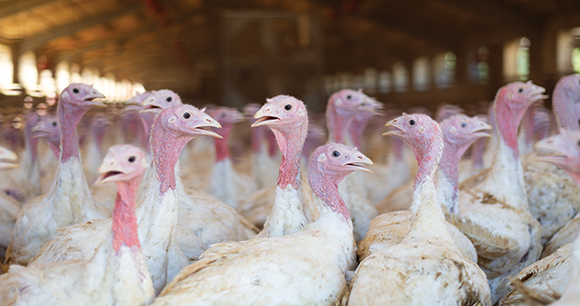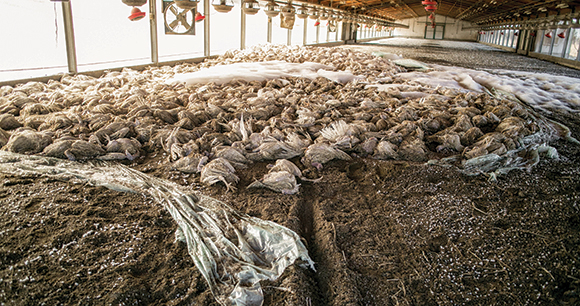It’s too small to see and too big to miss: The H5N1 virus, which causes highly pathogenic avian influenza (HPAI, aka bird flu), has wrought havoc on US poultry and dairy farms and wildlife, contributed to rising food prices, and made dozens of people sick—one fatally so. Since the current outbreak began in February 2022, Americans have collectively witnessed and struggled to navigate the most devastating animal health disaster in US history.

Over the last three years, an unfathomable 166 million domestic birds—chickens, turkeys, and ducks—have been killed either by the virus itself or by farm operators trying to prevent its spread. Once disease is detected in a flock, it is “depopulated” (all the animals killed). Increasingly, the method of convenience for doing so has become “ventilation shutdown plus” (VSD+), a horrific procedure that involves sealing the animals’ sheds (often containing several hundred thousand individuals), adding heaters and sometimes steam to increase humidity, and raising the inside air temperature to as high as 130ºF. The birds eventually succumb to heatstroke, but it can take hours—and even then, there are frequently survivors who must be found and (finally) killed.
Domestic flocks can become infected with HPAI when the virus is shed into the environment from the feces, feathers, and saliva of migratory or resident wild fowl carrying the disease. From there, it can come into contact with outdoor birds or be drawn through poultry house air inlets, where it can infect birds confined inside. The pathogen can also be transmitted from contaminated clothing, farm equipment, and vehicles—as well as the ventilation outlets of infected poultry barns nearby.
So how can the industry, as well as state and federal regulators, more effectively prevent, prepare for, and respond to bird flu infections? AWI has advanced multiple regulatory, research, and on-the-ground recommendations.
Petitioning APHIS to require more humane methods
In June 2023, we petitioned the US Department of Agriculture’s Animal and Plant Health Inspection Service (APHIS) to amend its rules regarding how it compensates producers for the costs associated with destroying poultry flocks infected with HPAI. Specifically, we urged the agency to mandate that producers seeking compensation develop comprehensive plans outlining how they will handle and kill their animals as humanely as possible in the event of an infection and subsequent depopulation. Importantly, as the petition notes, the plans should explain how the depopulation strategy will kill all animals as quickly as possible, and how the use of VSD+ will be avoided. APHIS has not yet responded.
Urging APHIS to consider smaller flock sizes
In September 2024, AWI again contacted APHIS, submitting detailed comments on a draft environmental impact statement (EIS) issued by the agency in connection with its HPAI response activities. As explained in our comments, one of the key shortcomings of the EIS was APHIS’s failure to consider requiring poultry farmers to restock with smaller flock sizes and lower flock densities. Research on infectious diseases suggests that larger farm sizes have the potential to promote larger livestock epidemics. And some studies, as well as our own analysis of USDA records, suggest that larger commercial egg production operations (those with 100,000 or more layer hens) are far more likely to become infected with HPAI than smaller operations.
USDA records also reveal that larger flocks take a longer time to destroy: Between February 2022 and July 2024, infected farms containing 10,000 to 25,000 birds took an average of 1.86 days to depopulate, while farms of 1 million to 5.5 million birds took an average of 9.54 days. According to the USDA, depopulation delays may increase HPAI transmission risk, as viral particles continue to disperse into the environment. Furthermore, the largest farms were more likely to rely on VSD+: about 54 percent of operations with 100,000 to 1 million birds used the method, while more than 92 percent of farms with more than 1 million birds did so.
Identifying urgent research priorities
In October 2024, the National Academy of Sciences (NAS) held a public workshop to identify research priorities to inform readiness and response to the ongoing HPAI outbreak. AWI sent the NAS a letter describing several urgent research needs. For example, we explained that APHIS must rapidly develop well-matched HPAI vaccines for poultry. Vaccination would greatly decrease birds’ risk of becoming infected and ensure that any birds who do become infected shed far lower amounts of the virus than they would otherwise. This would decrease the risk of spread to other farms, animals, and people. The USDA must approve use of HPAI vaccines, however, and negative impacts on international trade (due to other countries potentially barring products from vaccinated birds) have thus far been one of the primary reasons why HPAI vaccination has not been permitted for general use. Therefore, we also recommended undertaking research to ensure that all relevant impacts, including animal welfare, are incorporated into decision-making on this issue.

We also emphasized that additional research is needed regarding higher-welfare depopulation methods. Currently, the primary methods of mass killing used on commercial premises are VSD+ and low- or medium-expansion water-based foam. Both methods involve severe suffering. As mentioned above, VSD+ causes death via heatstroke, which causes damage to numerous body systems over the course of hours—and even then, not all birds die. Water-based foam kills faster than VSD+, but the way it kills—the bubbles block the birds’ airways—likely causes significant distress. Indeed, the United Kingdom’s Animal Welfare Committee has expressed concern over killing via water-based foam, characterizing it as “equivalent to drowning or suffocation … neither of which are recognized as humane under European legislation.”
Another widely used method of depopulation is gassing with carbon dioxide (CO2). In the United States, it is most commonly used to kill several dozen birds at a time in carts or containers. This approach is undesirable because, at high concentrations, the gas can cause pain and respiratory distress, and the catching and handling required to place poultry in carts or containers often results in injury and stress. Since only a relatively small number of birds can be killed at the same time, it can also take days or weeks to destroy an entire flock. Alternatively, studies suggest that CO2 whole-house gassing may be less aversive because it avoids having to handle the birds, and if gas concentrations are increased gradually, it may allow the birds to lose consciousness prior to experiencing severe discomfort.
Two higher-welfare and potentially more effective methods of depopulation that are currently being used in other countries are high-expansion nitrogen-filled foam and nitrogen whole-house gassing. Nitrogen gas kills by displacing oxygen in the air, creating anoxic (oxygen-free) conditions that rapidly lead to loss of consciousness in poultry, typically within several seconds to less than one minute. Because the gas is non-aversive and undetectable by birds, it is considered acceptable as a form of euthanasia. Unlike water-based foam, high-expansion nitrogen-filled foam creates large bubbles that do not occlude the animals’ airways. Further, nitrogen foam can be used even when buildings cannot be completely sealed.
The USDA recently acknowledged that it considers nitrogen whole-house gassing acceptable for caged poultry and high-expansion nitrogen-filled foam acceptable for confined, floor-reared poultry. However, neither method has, to date, been used in the United States for HPAI-related depopulations. There are several research gaps that, if addressed by the NAS or other scientific bodies, could help these higher-welfare methods replace practices such as VSD+, airway-occluding foam, and CO2 containers. For example, research focused on the logistics of nitrogen supply and commercial-scale application would be helpful, so producers in different regions of the country could understand how and where to obtain sufficient quantities of liquid nitrogen, particularly for the outsized barns often used in the United States.
Asking the AVMA to downgrade VSD+
Finally, AWI has worked with the veterinary community to discourage VSD+ and promote more humane depopulation alternatives. In 2019, the American Veterinary Medical Association (AVMA) published, for the first time, a set of depopulation guidelines. Last year, the AVMA issued a draft update and made it available for comment by AVMA members. In January, AWI (through our veterinary medicine consultant, Gwendolen Reyes-Illg, DVM) submitted more than 120 recommended changes to improve the accuracy and broaden the welfare considerations of the guidelines, with respect to VSD+ and other problematic depopulation methods.
In addition, we worked with veterinarians and animal protection groups to develop a sign-on letter urging the AVMA to reclassify the use of VSD+ for poultry (along with certain other mass killing practices) as a lowest tier, not-recommended method. More than 860 veterinarians and vet students signed the letter. Such a recategorization would be a critical step toward discouraging producers from resorting to VSD+, because it could mean that the USDA—which relies on AVMA guidelines to set some of its indemnification policies—might disallow compensation for flocks destroyed by this cruel practice.
As HPAI continues to tear through wild and domestic animal populations—threatening public health, creating financial hardship, and causing immeasurable suffering—AWI will continue to push for policies that decrease the risk of infections, reduce the spread of the disease, and prevent avoidable pain and distress, for humans and animals alike.